Xiamen, known as the "Garden on the Sea", is there anything worth visiting?
Arrived in Xiamen from Gulangyu at night and lived in Zengcuo 'an in the southeast of the island. It was once a fishing village with a history of more than 800 years. Now, due to the surrounding tourist attractions such as Xiamen University, Huli Mountain Fort, Huandao Road, Nanputuo Temple, Botanical Garden, etc., there are many shops, accommodation, cultural and creative bars, making it "China's most literary and artistic fishing village" and an important distribution center for tourists coming to Xiamen.

When there are many tourists, lawless elements will take advantage of the opportunity to make profits. Therefore, the Zengcuo 'an police station posted travel warnings in prominent locations to remind tourists to be vigilant and not to be deceived by "wild" travel agencies. Put up the notice here first. If you have friends who want to travel to Xiamen, it will be a "precaution" in advance. (The episode in the previous article "Gulangyu" was about encountering a bad travel agency)

The notice was seen early the next morning. When I got off the bus, I saw the unique coastal literary and artistic atmosphere of the tourist island city coming to my face. Shared bicycles were neatly arranged on the seaside road, and there were handsome men for tarot divination on the winding overpass. Across the road are winding food alleys with secluded paths. There are all kinds of southern Fujian and Taiwanese snacks such as seven-star fish balls, flat meat swallow, Buddha jumps over the wall, oyster frying, taro buns, sand tea noodles, and Dingbian paste. The bar on the corner is colorful and warm. The temples on the roadside are glorious and gorgeous...


I was deeply impressed by the glorious temple at night. I got up early the next time and went to check out a card. It turned out to be called "Fuhai Palace". The sculptures on the roof and door posts are complex and gorgeous, quite in a Lingnan carving style. The emperor Baosheng is enshrined in the palace. It is a long-standing folk belief in Fujian. People call him Immortal Wu. It is said that he was a good doctor who helped the world during his lifetime. He had excellent medical skills and noble medical ethics. Countless people benefited from him and were revered as a "miracle doctor." In addition to southern Fujian, Taiwan, Chaoshan in Guangdong, Hong Kong, Macao and Southeast Asia all respect Emperor Baosheng as the god of medicine.

The road to the south of Zengcuo 'an is Huandao Road. It is one of the scenic tourist roads around the sea in Xiamen City. It has a total length of 43 kilometers. It is surrounded by mountains and seas. Linghai bridges and penetrates stone drilling holes. It has both transportation and tourism functions.

The Huandao Road is natural and fresh, elegant in taste, and beautiful. The "East Ring and Wanghai" along the road has been rated as one of the top 20 new scenic spots in Xiamen. Zeng Cuo 'an is located in the section from Xiamen University to Qianpu. The coast here is about 9 kilometers long, with clean beaches and rich landscapes. It is called the "Golden Shoreline".

There is a Xiamen Calligraphy Square on the golden coastline, which displays the works of famous calligraphers in our country's history and contemporary calligraphers in Xiamen. Its design theme is "Book Lu Island in Mind, Show the Pride of the Sea", and the design concept is "Use the sky as paper and the sea as ink". Such a seaside calligraphy and sculpture square is really rare.
The sculpture below shows Mr. Luo Dan, a famous Fujian calligrapher, with his calligraphy works behind it.

The picture below is a group of stone carvings named "The Beginning of Chinese Characters". The stone on the left is engraved with "Sanshi Pan Inscription". The Sanshi Pan is a bronze vessel in the late Western Zhou Dynasty. The inscription on it is a contractual document delimiting the boundary between the two countries. The font is elegant and unrestrained, opening the end of the grass seal; The stone in the middle is engraved with a table of bone bones and branches. The ancients used the bone bones to record the time. From Jiazi to Guihai, ten days were a cycle, called "ten days". On the second day of every ten days, the good and bad luck of the next ten days were regularly divined, namely "Buxun". Buxun was the most common among various divination activities in the Yin Dynasty, so Buxun also had the most oracle bones; The stone on the right side is engraved with a fragment of a pottery basin with a human face fish pattern. The original object is the Yangshao Culture painted pottery unearthed at the Banpo site in Xi'an. It dates back 7,000 - 5,000 years. The pattern of the human face fish pattern is related to totem worship and is currently known to be the earliest works to express the human face in painting.

There is also a story carving of "Mi Dian Bai Shi" on the square. Mi Fu, a great calligrapher and painter in the Song Dynasty, was very obsessed with strange stones. It is said that when he first entered the state office, he called him brother when he saw the strange stone and bowed three times and kowtowed nine times. As a scholarly and elegant story, he has been passed down as a beautiful story.

Shortly after heading west along the seaside trail, we arrived at the Hulishan Battery.
The Hulishan Fort was a product of the Westernization Movement in modern China. Because of its important position, it was historically known as the "Gateway to the Eight Fujian and the Key to the South of China." The fort was built in the 20th year of Guangxu of the Qing Dynasty (1894), with a total area of more than 30,000 square meters. It is divided into Zhanping District, Yingbing District and Houshan District. The structure of the fort is semi-bunker and semi-city wall type, with European style and the architectural charm of the Ming and Qing Dynasties in our country.
Cross the 100-meter banyan road to the top of Fort Hill.

The mountains are lush with flowers and powerful cannons. Isn't this Chopin? Flowers symbolize beauty and bloom, and cannons represent destruction and power. Isn't this similar to "guns and roses"? A simple scene actually reminds people of the two giants of classical and rock and roll, as well as the two energies of contrast and dialectics.
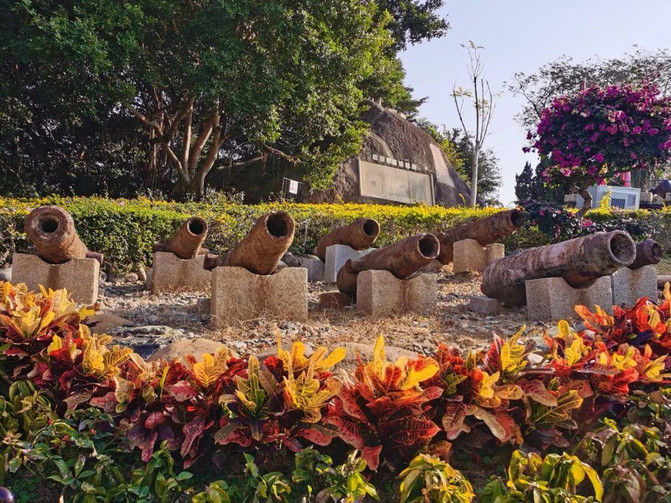
The prickly red flowers on the bunker can also give people daydream:
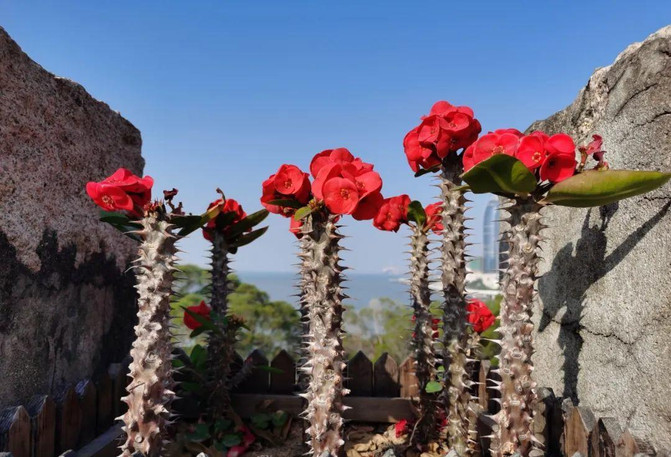
Looking around, you can see the Xiamen Twin Towers again. On sunny days, you can still overlook Kinmen Island.

The small island looming in the distance from the ship is Kinmen Island:

The treasure of the Hulishan Battery is the Krupp cannon below. It is the largest breech coastal cannon made in the 19th century in the world and completely preserved at the original site of the battery. It was selected into the Guinness World Records of the Shanghai World and is known as the "World Cannon King".

(Big artillery head)

During the Japanese invaders 'invasion of China, the cannon king once sank Japanese ships: on September 3, 1937, three Japanese ships suddenly sailed in front of the Dadan Island Lighthouse to attack the building. The Xiamen Fortress Battery fired fire back, and the Krupp cannon concentrated on the enemy's "Indozhu" destroyer in the middle, causing a large amount of water to enter the starboard side of the ship and seemed to sink. When the other two ships saw this situation, they fled in panic.
(Historical Materials Battery Exhibition Room)

The following five cannons were discovered on Zengcuo 'an Beach in 2008. They are historical relics of the Zengcuo' an Fort in Xiamen in 1841.

The picture below shows the Wisworth cannon, also known as the "hexagonal cannon", used from 1840 to 1900. The strangeness of this gun is that the inner diameter of the barrel is hexagonal. The original intention of the design is similar to the rifling of a gun. The purpose is to allow the shell to follow a certain trajectory and maintain a stable trajectory. However, the early rifling processing technology is not yet in place. The hexagonal gun is a transitional gun between the smoothbore gun and the later linear bore gun.

There is also a martial arts hall and a 4D cinema in the park, which reproduces the scenes of Xiamen's Anti-British Defense War and the Anti-Japanese Defense War, allowing you to understand the extraordinary years of Xiamen Island in modern times.

The fort also has a sandy plant area where cacti and succulents are planted. It is a green belt with desert characteristics in the park, adding a colorful scenery with evergreen seasons to the fort.

The picture below shows the Hongyi artillery group. Entrepreneur Zhou Hongyi loves to wear red clothes, his name sounds like "red clothes" and his character is straightforward and quick. People call him the nickname "Red Clothes Cannon". In fact, the proper name is "Red Yi Cannon"."Yi" refers to foreigners. Because the Red Yi Cannon was introduced from Macau through Guangdong by the Dutch in 1600, and the Dutch have red hair color, hence the name. Also because the Qing emperor taboo the words Hu, Lu, Yi, and Di, it is also called "Red Clothes Cannon". The red-clad cannon has a low center of gravity and is not easy to explode the chamber upside down. The gun body is equipped with sight and door, which has a high hit rate. However, the gun body is heavy and can only hit directly and cannot rotate. Xiamen City Bougainvillea is planted in the artillery group. The bright red Bougainvillea means that there is a lot of artillery fire, creating an atmosphere for the artillery group and adding color to the scenic spot.

There is a daily exercise of Hongyi artillery and Qing soldiers here, which reflects the military glory of the Xiamen Port Battery during the Ming and Qing Dynasties. Friends interested in history and military affairs should check the time when visiting and don't miss it.

Returning to Huandao Road after coming out of Huli Mountain Fort, I encountered a small but clever "White Snake" overpass after the "Changlong" overpass the night before. It also looked like a rocket about to be launched into space. It seems that the Huandao Road architecture combines practicality and art. Not far ahead, you will arrive at Xiamen University. Like Yunnan University and Wuhan University that you have visited before, Xiamen University is also one of the most beautiful universities in China. In previous years, in addition to students and tourists, the campus was named "Xiamen University People's Park" by the locals. Unfortunately, Xiamen University was temporarily closed due to the epidemic. Looking at the swimming pool building through the door, there was still a design.
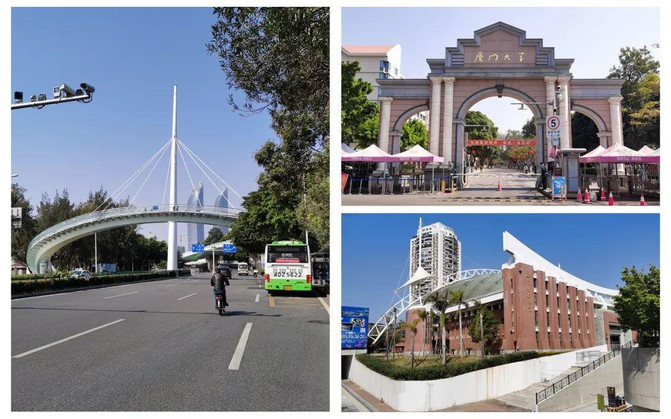
Walking north and seeing the white towers and green temples among the green mountains and clear waters, this is Nanputuo.

Nanputuo Temple is located at the foot of Wulao Peak and faces the Bicheng Harbor. It was built in the late Tang Dynasty. Because it worships Guanyin Bodhisattva, and the Guanyin Dojo is located in Putuo Mountain in Zhejiang, it is named "Nanputuo Temple" and is one of the Buddhist resorts in southern Fujian. The temple contains precious cultural relics such as the "Miaofa Lotus Sutra" in blood during the Wanli period of the Ming Dynasty and He Chaozong's famous white porcelain Guanyin.

The main buildings of Nanputuo Temple include the Tianwang Hall, the Daxiong Hall, the Great Compassion Hall, the Sutra Pavilion, etc. on the central axis. There are Bell and Drum Towers, Zen Hall, Guest Hall, and Warehouse on both sides. There is also the Southern Fujian Buddhist Academy and the Buddhist Nursing Hospital. There is a free life pool in front of the temple. In recent years, a new memorial tower for Master Taixu has been built behind the temple. The whole temple is magnificent and orderly.

After entering the mountain gate symbolizing the "Three Gates of Liberation", the white pagoda appears in front of you. This is the Longevity Tower. The east and west towers stand on both sides of the release pool. The tower is eleven stories high, white and contains vitality. The towering twin towers overlook the entire temple and are an eye-catching symbol of Nanputuo Temple.

In the main hall of the temple, there are three Western holy statues (Amitabha, Avalokitesvara, and the Buddha of the Great Trend) and the eighteen Arhats, and there are an endless stream of worshipers.

There are four Guanyin Bodhisattva statues in the Hall of Great Compassion, facing in all directions, with two-armed Guanyin in the middle, and the other three statues are forty-eight-armed Guanyin. Each has a hand eye carved in its palm and holds various magical instruments, with different postures and each achieves its own perfection.

There are many cliff stone carvings on Wulao Peak behind the temple. Among them, the character "Buddha" is the most eye-catching. This character was written by Monk Zhenhui during the Guangxu period of the Qing Dynasty (1866). It is more than 4 meters high and more than 3 meters wide. The strokes are full and vigorous., comfortable and broad-minded.

Not far north of Nanputuo Temple is the Xiamen Garden and Botanical Garden. Many cities have botanical gardens, which are similar, but there are several cities with extraordinary botanical gardens and cannot be missed. The Tropical Botanical Garden of the Chinese Academy of Sciences (Xishuangbanna), which you will visit in the future, is one of them, and this Xiamen Garden and Botanical Garden is also one.

Xiamen City Garden and Botanical Garden was founded in 1960 and is located in Wanshi Mountain in the southeast corner of Xiamen Island. It covers an area of 4.93 square kilometers. It is a comprehensive botanical garden integrating plant species preservation, scientific research, science popularization, ecological protection, and tourism. More than 7000 kinds of plants have been introduced into the park from all over the world, including more than ten special parks such as palm plant area, succulent plant area, gymnosperms area, exotic plant area, ginger plant area, and rainforest world. There are also famous scenic spots in Xiamen such as "Taipingshixiao","Tianjie Xiaozhong","Wanhu Chaotian", and "Wanshi Hancui" and famous temples in southern Fujian such as Tianjie Temple and Taipingyan Temple. Plant landscapes, natural wonders and cultural scenery blend with each other, and the scenery is beautiful, refreshing and makes people forget to leave.

Soon after entering the gate of the garden, I saw "Thousands of stones and green". There is a lake in the Wanshi Mountain, surrounded by thousands of green and green mountains.

On the south side of Wanshi Lake is the Araucaria sparse forest lawn. On the southeast side of the lawn, a piece of Norfolk Araucaria forest is planted. It is currently the largest pure Araucaria forest in my country. Looking from afar, the tall fir trees are graceful, like an arc drawn by a flying monkey. There is also a large-leaf camphor tree here, which was planted by Deng Xiaoping during his inspection of Xiamen in 1984.

On the west side of the lawn is the Hundred Flowers Hall, and in the center is the Lotus Pond. Lotus, royal lotus, and various water lilies on the pond display their charm. In the surrounding corridors, you can admire the large flowers and old duckbills, pole vines, lotus mist, hanging melon trees, worry-free trees, and golden tea. Although it is a small garden, there are no lack of ancient vines, paths and stones. The moss is dense, and there are infinite mountains and rivers in the distance. Especially the "flower fairy" dancing in the lake, with a plump figure and charming posture, which is stunning.

On the north side of Baihuating is a strange and interesting plant area, with 200 kinds of strange and interesting plants, such as the world's most endangered old man's palm, the Centenary orchid, which has only two leaves in its lifetime but can live for more than 2000 years, the strange-shaped decorated cycads, unique colors Black dragon bamboo, black grass bamboo, white flowers and kapok with belly as big as a ball, commonly known as the "Maitreya tree", the most poisonous plant sees blood and seals the throat, the plant that can prey on animals, the jumping grass that can dance when hearing music, eat a mysterious fruit that can change your taste... Eye-opening!

On the east side of Wanshi Lake is the palm plant area. Hundreds of palm plants are spread all over the water pits and small slopes. They are of varying heights and have different branches and leaves, filling the scenery of small islands in the south.

The king coconut beside the road is tall and powerful, very eye-catching. King coconut is native to Cuba and is the national tree of Cuba. It is tall and straight, majestic, beautiful, with a straight trunk and a swollen middle. The king coconuts arranged here are like rows of missiles ready to be launched, and are jokingly called the "missile base" by tourists.

There is Tianjie Temple, also known as "Drunken Fairy Rock" on the middle and small mountains of the garden. In the past, the bell was rung 108 times in the early morning to "wake people up from their dreams." Next to the temple are Liquan Cave, Changxiao Cave, Kuangyi Terrace and the poem wall of the Ming Dynasty anti-Japanese generals.

The top of Camel Peak where the Tianjie Temple is located is where the "Tianjie Dawn Bell", one of the twenty famous scenery in Xiamen. When the bell rings in the temple, the bell rings melodious far away, and the afterglow echoes in the valley and can be heard under the mountain. Climb to the top of the mountain and you can overlook the scenery of Xiamen City. Xiamen is known as the "Sea Garden." If it were not for the Botanical Garden, the charm of the Sea Garden might be inferior.

(Encountering curious little meow)

After going down the mountain, I came to the succulent plant area. The plants here left the deepest impression on me.
More than 3000 species of cactus and succulent plants of various types are cultivated in the succulent plant area. They have strange shapes, beautiful colors and myriad postures when they bloom. Succulent plants have developed water-storage tissues and often use a unique sedum acid metabolic pathway for photosynthesis to fix carbon dioxide. There are outdoor exhibition areas and greenhouse exhibition areas here. There are Wu Lun pillars, elephant leg trees, bottle stem trees, baobab trees, etc. Outdoor, and the greenhouse has rare moire kapok, ghost heads, immortal jade, purple kudzu, etc.

Many meaty names are very poetic. The picture below includes Baixing, Ivory Pills, Songxia Zhuihua, Jinsheng Pills and other varieties. Can you take into account the names and shape?

Say goodbye to the fluffy and fleshy, and we are facing the deep Changshou Gorge. The narrow canyon only allows one person to pass through, which seems to reveal that longevity has been rare since ancient times. The red character "Shou" is carved with carved dragons and dancing phoenixes, and it is handsome and elegant.

There is a record in "Peach Blossom Spring" that "at the beginning, it is narrow, and only then can people understand, but after a row of ten steps, it suddenly becomes clear." As soon as I passed through the Changshou Gorge where "only people can understand", I immediately ushered in a small Taoyuan that "suddenly becomes clear". It really lives up to its name of "Taoyuan". The water heart and mountain bones, the water and stone sublimate, and the tide sound and fish caves are stacked and connected with clouds...

Follow the secluded path north, pass through the stone door, circle the green pavilion, and arrive at Taipingyan Temple.

There is a strange stone outside the temple-Taiping Smile Stone. It is made of four natural huge stones stacked on top of each other to form an opening and smiling shape. It can be said that the stone becomes a scene. Laughter is contagious. Even the smile of a stone makes tourists passing by feel happy.

Taipingyan Temple was built during the Wanli Period of the Ming Dynasty (1573-1620). It was originally a Taoist temple dedicated to the Jade Emperor and was called the "Taiping Temple". At the end of the Ming Dynasty and the beginning of the Qing Dynasty, Zheng Chenggong occupied the Jin and Xiamen Islands to resist the Qing Dynasty. He once used Taipingyan as a place to study in his spare time. Today, there is the ruins of Zheng Chenggong's reading office here. After Zheng Chenggong crossed eastward, the temple was destroyed. In the early years of Qianlong of the Qing Dynasty (1736-1745), Monk Ruyuan, the abbot of Nanputuo Temple, raised funds to rebuild the temple, changed the temple into "Taiping Rock", and preserved the "Temple of Heaven" in the side hall where the Jade Emperor was honored.
(Taipingyan Temple sculpture sends out a child Guanyin)

In addition to the Taiping Laughing Stone, there are also strange stones in the garden such as Elephant Trunk Peak and Wanhu Chaotian.
Elephant Trunk Peak is hidden in the mountain forest on one side of Rose Garden. If you don't look carefully from a specific angle, it will not be easy to find. It is shaped like an elephant hiding in the mountain.
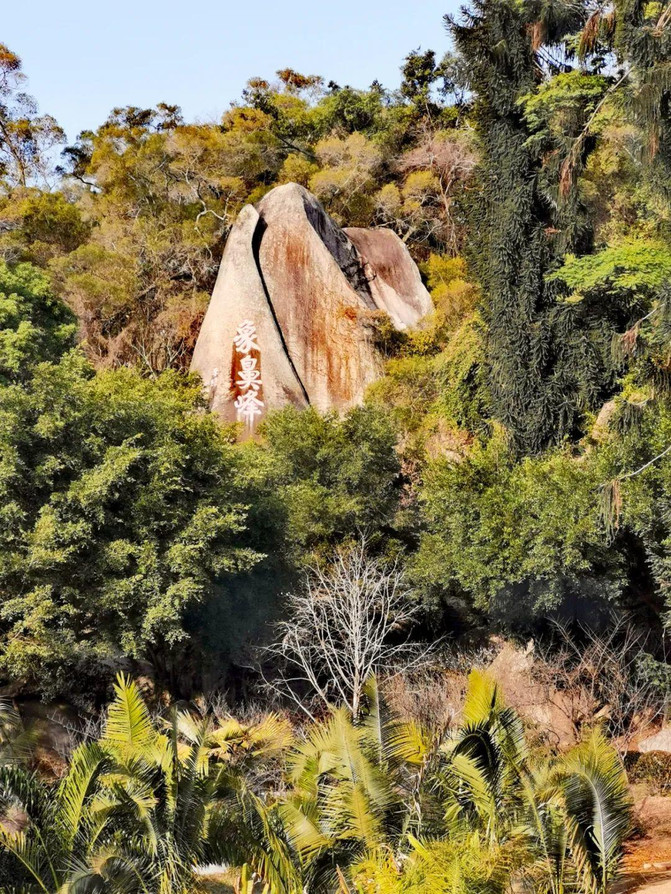
"Wanhu Facing the Sky" is located on the top of Wanshi Rock. It was titled by Li Zhang, a fellow knowledge of Xiamen's coastal defense during the Yongzheng period of the Qing Dynasty. It compared the rocks in the mountains to the sky, vividly depicting the scene of thousands of stones standing high into the clouds.

As a coastal tourist city, beyond mountains, rivers and history, there is no lack of vitality and fashion. Zhongshan Road Pedestrian Street is such a bustling and lively street that never sleeps.
It was already afternoon when the Botanical Garden came out to Zhongshan Road Pedestrian Street. The small shops and graffiti, colorful houses and trendy toys along the road showed vitality and personality, exuding romance and fashion.

Arriving at Zhongshan Road Pedestrian Street in the evening, a retro fashion style blows to your face.
Zhongshan Road Pedestrian Street is an old commercial street in Xiamen. It is rich in commodities and is very popular. It is another iconic impression of Xiamen for people other than Gulangyu. It represents the prosperity of old Xiamen and is also full of the rhythm of the times. It retains a relatively complete neighborhood with modern historical features, including many cultural monuments such as Xiaozouma Road, Chen Huacheng's former residence, the First Holy Hall of China, as well as Nanyang arcade, a dazzling array of Fujian and Taiwan snacks, and the ancient Nanyin echoing in the alleys and neighborhoods. Some eat, some watch, and some listen. It is worthy of being called a "famous historical and cultural street in China."

The above attractions are all located on Xiamen Island. The article "Gulangyu" mentioned that Xiamen City also includes Haicang Peninsula, Jimei Peninsula, Xiang 'an Peninsula and other places on the surrounding mainland. Among them, Jimei School Village on the Jimei Peninsula in the north is also a must-see place when visiting Xiamen. Next, we will go to Jimei School Village for a stroll.
Jimei Xuecun is located in Jimei Street on the north side of Xiamen Island. It is backed by Tianma Mountain and faces the sea on three sides. It is the magnificent gateway to Ludao and the hometown of Mr. Chen Jiageng, a patriotic overseas Chinese leader. He founded Jimei School (later Jimei University) here, giving Jimei the reputation of "School Village" and "Hometown of Overseas Chinese".

Walking into Jimei Street, you can see an additional pool of water. This is Dragon Boat Pond. Around the pool, there are Western-style school buildings and Chinese-style pavilions and corridors with cornices. From time to time, you can meet teachers taking children learning painting, sketching the beautiful scenery on the other bank on drawing paper.

There are still several dragon boats parked in a corner of the lake. The Jimei Dragon Boat Festival International Dragon Boat Race is a grand event that has lasted since 1955 to this day. When he was running a school, Mr. Chen Jiageng focused on improving the health level of students and actively advocated water sports. In 1950, he organized the construction of embankments on Xunjiang Beach to carry out boat racing activities. In 1953, he personally supervised the construction of dragon boats and organized rowing training for teachers, students and villagers. Later, a dragon boat race was held, which was the predecessor of the above-mentioned competition.

Jimei Middle School by the pool was founded in 1918. It has a long history and has students all over the world. It is known as a "Famous School in China". There are also Jimei University and Jimei Primary School on the street. They are both well-known schools and worthy of being a "school village". There is a Nanxun Building on the east side of Jimei Middle School. It was completed in 1959 and was personally presided over by Mr. Chen Jiageng. It is 15 stories high and was the tallest building in Fujian Province at that time. It combines the characteristics and advantages of Chinese and Western architecture and is one of the landmark buildings of Jimei Xuecun.
(Nanxun Building)

The most worth seeing in Xuecun is Jiageng Park. The park was built by later generations in memory of Mr. Chen Jiageng. According to the traditional garden layout, it integrates commemorative, cultural and recreational features, including Ao Garden, Museum, Liberation Monument and other attractions., pavilions and pavilions are scattered high and low, and the scenery is pleasant.
(The four characters "Jiageng Park" were written by the calligrapher Gao Huai)

The most solemn building in the park is the Chan Jiageng Memorial Hall. We visited the museum first to learn about the deeds of some great men.

Chen jiageng (1874-1961) was an outstanding overseas Chinese leader, industrialist, educator and social activist. In his early years, he traveled south to Singapore to do business and became the first generation of Chinese manufacturers well-known at home and abroad. At the time of national crisis and danger, he advocated that "education is the foundation of the country, and the development of schools is the natural duty of the people." He was committed to establishing education and other public welfare undertakings (Xiamen University was also founded by Mr. Chen Jiageng). He supported the Revolution of 1911, led overseas Chinese in Southeast Asia to support the motherland's War of Resistance, and actively participated in politics after the founding of New China. He has always been at the forefront of the times.
(Chen Jiageng runs a school, and the world is full of peaches and plums)
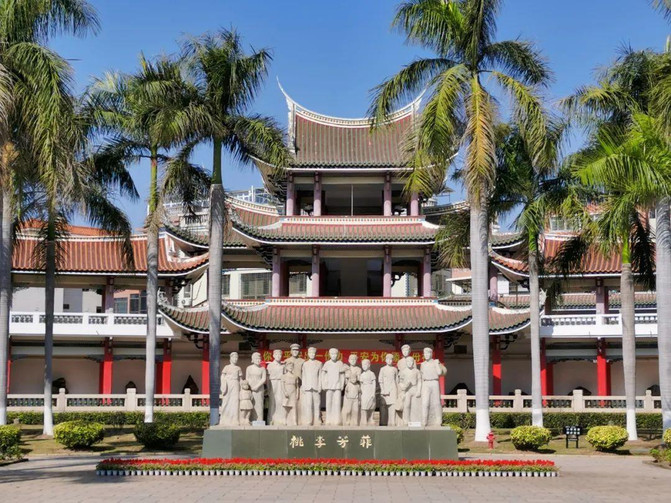
The museum displays Mr. Tan Jiageng's life experiences at every stage, including business, running schools, and politics. Along with his motivation and understanding for everything he does, some of the things he said are still enlightening, such as:
When doing business,"to compete with your peers, you must use a beautiful spirit and a sincere attitude."
When running a school,"I am willing to serve the public, but it is a lifelong purpose. I also think about social undertakings, we should follow our efforts at any time and do it gradually. If we want to wait until we get rich, there will be no day for us to do it."
When saving the country,"every man is responsible for the rise and fall of the world, personal wealth and property can be sacrificed, and the right and wrong of things must be clearly distinguished."
(Scene of Mr. Chen Jiageng's speech at the first session of the National People's Congress)

As the head of the family with many children and grandchildren and wealth, Tan Kah Kee has unique views on children and property issues. As early as 1918, Tan Kah Kee decided not to leave his property to his children and grandchildren, reflecting his extraordinary outlook on life and son.
(Chen Jiageng's family photo)
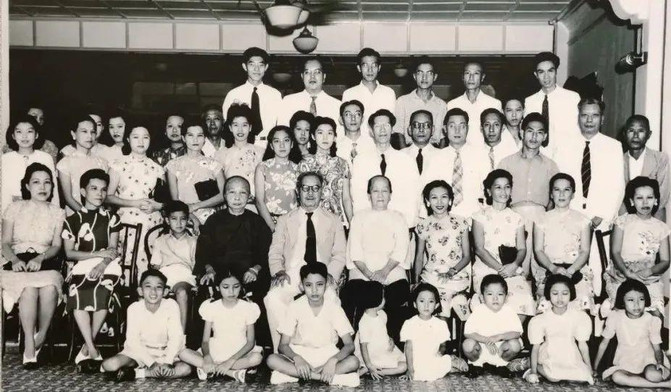
Aoyuan is another scenic spot in Jiageng Park. It is divided into three parts: the porch, Jimei Liberation Monument and Mr. Chen Jiageng's tomb. The two sides of the porch are engraved with 40 bluestone embossed of ancient and modern historical figures, in various shapes and vivid images. In the center of the park stands the Jimei Liberation Monument. The monument is 28.6 meters high, with eight levels on the lower level and three levels on the upper level, symbolizing the eight-year War of Resistance and the three-year War of Liberation. It is surrounded by blue stone carvings, which is the most conspicuous building in the whole park.

There are also traditional ancient pavilions and leaf-leafed banyan trees dotted in the garden. The scenery is solemn and interesting and full of ancient flavor.

Not far from the park is Tan Jiageng's former residence, which was built in June 1918. From June 1919 to March 1922, Tan Jiageng personally planned the establishment of Xiamen University and the expansion of Jimei School Village here. During the Anti-Japanese War, this building was bombed by the Japanese invaders. After liberation, following Mr. Wang's instructions, the school building was first repaired. This building was not repaired until 1955. From August 1958 to October 1960, Mr. Chen Jiageng lived here again.

There are also many buildings in Jimei Street (such as Jianye Building) that are related to Mr. Chen Jiageng, so I will not introduce them one by one. However, there is a temple that is different in architectural style from the Republic of China. It has a similar pattern and the same gorgeous roof as the Fuhai Palace mentioned at the beginning of the article. It is exactly the same as the Lingnan architectural decoration seen in Guangdong. Maybe Lingnan and southern Fujian have some origins. Culture.

This is the end of my trip to Xiamen. After enjoying the wandering, I passed through the Garden Island and the Music Island, and thought that if one day I longed for stability, the Xia drums of the egret piano might be a good choice...
Next stop, Quanzhou!
Previous Article:Xiamen| As time goes by, I want to love you as always
Next Article:Because of "you", I fell in love with a city: Jimei, Xiamen, Travel Notes in Southern Fujian
